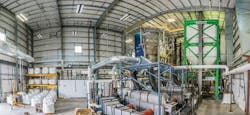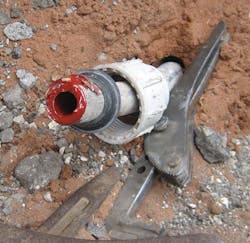Sustainable Water Infrastructure: Rethinking water and wastewater systems with resilience in mind
By Sarah Fister Gale
Sustainability is about a whole lot more than “going green.” For water and wastewater utilities, sustainability is about creating reliable, consistent infrastructure that can be managed, maintained and upgraded - without destroying the environment or bankrupting users.
“Sustainability is an intrinsic part of what utilities have done for years,” said Andrew Shaw, associate vice president and global practice and technology leader for Black & Veatch in Houston. Sustainability became a priority with the Clean Water Act, but over time, leading utilities and engineering firms have evolved beyond meeting regulatory requirements to setting broader environmental and social goals. “We are beginning to rethink how we do things and to focus more on resilience of the water system by ensuring that we have safe water to drink - and that we reduce the energy we use to generate it.”
Get it Before it’s Gone
One of the biggest transformations to emerge from this new mindset is the transition from looking at wastewater treatment as a removal process to a resource recovery operation. This is especially true of phosphorus, which is a vital ingredient in fertilizers and a common pollutant in wastewater. “Phosphorus is a non-renewable resource, and if we don’t start recovering it from wastewater, we are going to have to start mining it from the sea,” Shaw explained.
His team has seen growing interest from wastewater utilities in phosphorus recovery projects as a way to benefit the environment - and turn a profit. In December 2015, Black & Veatch completed work on a $30 million phosphorus recovery project at the Stickney Water Reclamation Plant (WRP) in Illinois. The plant now removes 1,150 tons of phosphorus annually from treated wastewater and converts it into a slow-release fertilizer that reduces pollution and generates revenue. The fertilizer made with the reclaimed phosphorus crystals is not water-soluble, which means it won’t generate harmful runoff to nearby streams. “What once was waste is now a revenue-generating product,” Shaw said. “It’s a win-win.”
His team also recently completed an assessment of the feasibility of a similar project for Medina, Minn., to build a $35 million anaerobic digester that could produce sludge for fertilizer and compost as well as methane for the operation of two generators.
The environmental benefits and long-term revenue generation opportunities from these kinds of projects are clear, though they require a lot of capital investment, which can be a hard sell for many organizations with limited budgets and skeptical rate payers. “Even utilities in the most well-off communities will never have the level of revenue they need to tackle all the work that needs to be done,” said George Hawkins, general manager of the District of Columbia Water and Sewer Authority. “So the financial aspect of sustainability is really important.”
Utilities have to consider the financial, social and environmental aspects of sustainability when choosing projects, noted Mike Lunn, manager of the environmental service department for the City of Grand Rapids, Mich., a recognized Utility of the Future (UOTF) by the National Association of Clean Water Agencies and other industry associations. “Sustainability is about focusing on the triple bottom line,” he said. His department uses these goals to inform decision making about all of their projects, from choosing green infrastructure over gray to implementing a new energy efficiency program that will save taxpayers $2.2 million in energy costs through 2031.
“You also need to think about governance,” he said, noting there is no point in building infrastructure if you don’t have the resources or expertise to manage it for the long term. “You have to think through the long-term implications of these projects to be truly sustainable.”
Thanks to advances in technology, utilities now have a wide array of sustainable innovations that help them reduce energy, shrink their footprint and save money. Though some require a bigger investment - and culture change - than others, said Shaw. “The technology exists but it isn’t inexpensive,” he noted. “It can be hard to bring these kinds of innovations to an industry that has followed a very efficient and low-cost way of doing things for a long time.”
Along with the cost there is a significant culture change that comes with a lot of these projects. “It has never been the job of a wastewater utility to produce things, it is their job to get rid of things,” Shaw said. “It can require a significant shift in thinking.”
To clear the financial and cultural hurdles, Hawkins suggested starting with innovations that are easily applicable to the current operation and apply to processes that are already in the budget. DC Water, for example, is implementing Xylem Flygt Concertors, smart water pumps that automatically adapt the amount of power they use in response to the flow of water. By sending a stream of data back to operators, the pumps also communicate their performance and maintenance needs.
“Every water authority has money in the budget for pump acquisition and maintenance,” Hawkins pointed out. So choosing a smart pump is a low-risk, low-investment decision that immediately begins to deliver environment and financial benefits. “These kinds of decisions can be a lot easier than implementing a project that will save money in the long term but has high short-term costs.”
The Softer side of Sustainability
For many utilities, it takes a crisis or restrictive new regulation to force a change in thinking about these kinds of issues, noted Karen Pallansch, CEO and general manager of Alexandria Renew Enterprises (AlexRenew) in Alexandria, Va., also a recognized UOTF. For AlexRenew, that “crisis” was new Chesapeake Bay requirements to remove nitrates and phosphorus from wastewater. “It required us to implement state-of-the-art technology along with a major culture change in a very short amount of time,” she said.
The utility spent $350 million over six years to transform its traditional treatment facility into an automated plant with new technology that is operated by monitoring instruments and analytics software to ensure all water exiting the facility is as clean as possible at all times. Along with paying for the new system, the utility paid for many of its employees to complete training programs and secure new licenses to ensure they had the skills to operate the new plant.
Pallansch noted that with this kind of fast-moving high tech project, training can be overlooked - but it is critical to success. “If people are not confident in their ability to manage this technology, they won’t be able to use it,” she said. “You need to invest in the human side to make it work.”
While the transformation was challenging, it helped AlexRenew evolve its thinking toward a more sustainable approach to wastewater management. It also made the leadership team more receptive to new ideas about how to efficiently remove nutrients and reduce energy use while delivering clean water.
For utilities whose hands aren’t forced by a crisis, Pallansch recommended they start by setting goals around sustainability then reading everything they can about what’s already been accomplished. “Don’t just focus on industry journals,” she advised. “Read Fast Company, the Harvard Business Review, and business magazines to see what folks are doing in other industries and how it might apply for you.”
Then start with pilot projects to demonstrate small wins and begin to transform the organization’s perceptions about the financial, social and environmental benefits of sustainability. “If you do a lot of little things, it can have a big impact,” she said. “That’s often what innovation is all about.”
About the Author: Sarah Fister Gale is a Chicago-based correspondent forWaterWorld. Over the last 15 years, she has researched and written dozens of articles on water management trends, wastewater treatment systems and the impact of water scarcity on businesses and municipalities around the world.
Pipe Lining to Prevent Lead Release
By Amanda Strouse
The national lead leaching issue is a major concern not only for the general public but also for the municipalities that have to pay for water testing and pipeline repairs. Closing down streets and destroying landscape to dig out pipes is incredibly expensive, destructive, disruptive and time-consuming. The good news for utilities is that there is a better way to bring lead leaching into U.S. EPA compliance without having to tear out the pipes: in-place pipe lining technologies.
A recent study by the Water Research Foundation (Report # 4351) found that pipe lining and coating technologies, using a non-destructive in-place process, can effectively reduce or eliminate release of lead from lead service lines (LSLs). The many benefits of pipe lining also include a much-reduced project timeframe, little to no destruction of streets or landscape, no traffic or parking disruptions and a long-term solution against lead leaching, leaks and other common problems.
Amanda Strouse is on the marketing and public relations team for pipe-lining technology innovator, ACE DuraFlo, the creator of the patented ePIPE epoxy coating system. For more information, visit epipepinfo.com.



